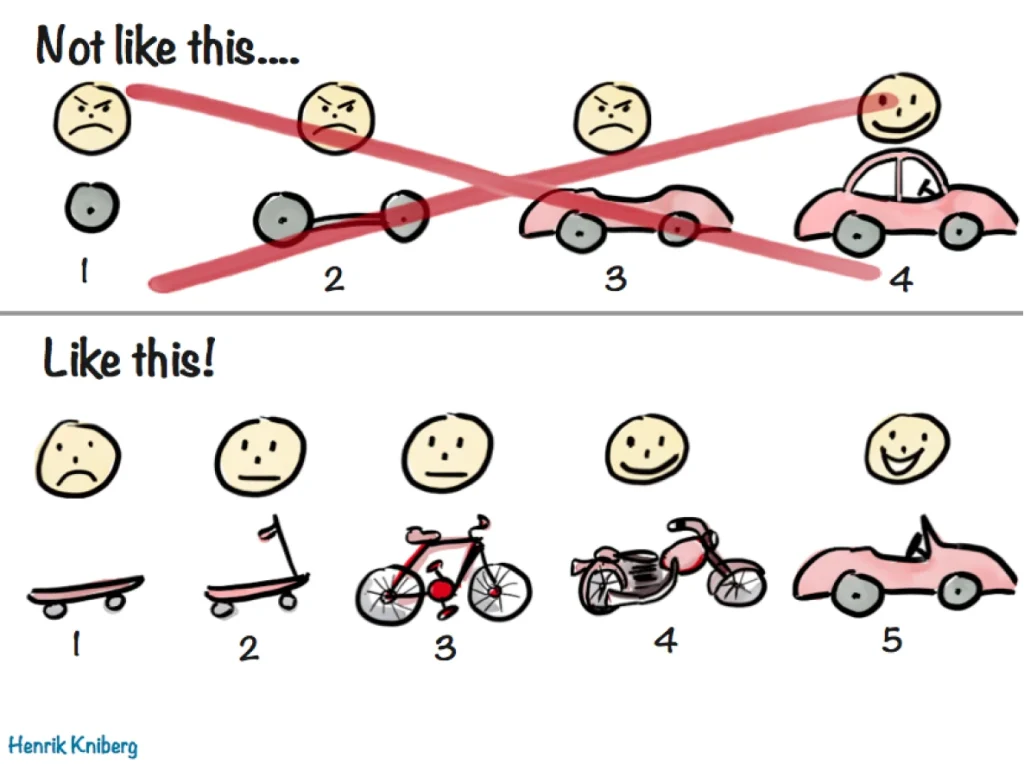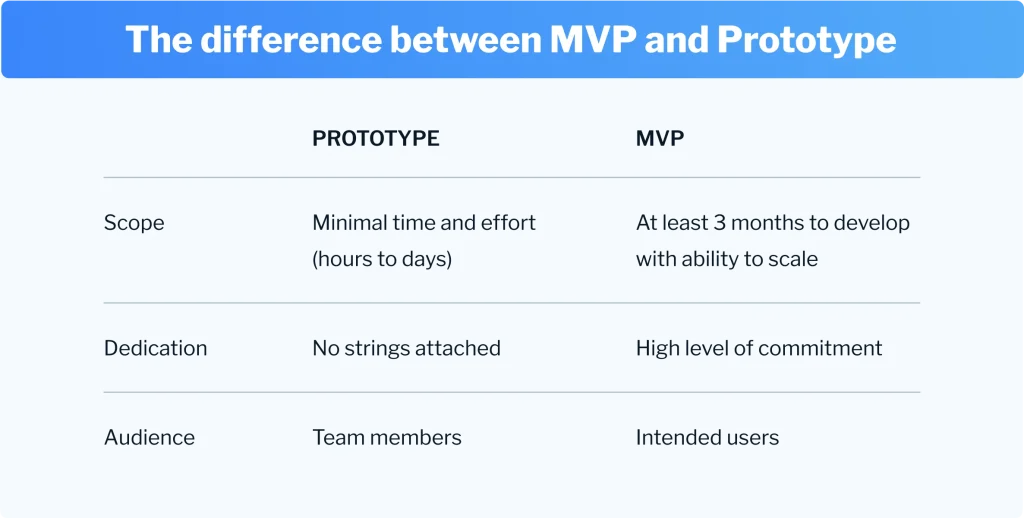We use cookies to ensure we give you the best experience on our website. By clicking Agree you accept our Privacy and Cookies Policy.
MVP vs. prototype in startup software development: what’s the difference?

 16 minutes read
16 minutes read
Content
A journey from initial idea to final product involves many steps. And with new product development, it’s never a straight path – you need to try out different solutions before you come up with the right one.
All these manipulations require a significant amount of time and expenses. What’s worse, you need to decide on the overall approach to startup software development.
Look, I get it. Releasing a product without testing is reckless. And you’d be right to look for an optimal way of dealing with it.
In the end, it all comes down to prototyping or building an MVP. But which one should you bet on? Let’s find out together.
Prototype vs. MVP: what is prototyping and how to use it
Prototyping stands at the core of the lean startup approach and Agile methodology. It’s intended to match the product’s functionality with users’ needs and make it more market-ready.
What does prototype mean in software development? In a nutshell, a prototype is a virtual sample of a product or service. With a product prototype, you can shape your concept into a tangible form and pitch it to investors and potential users. In this way, you can gather feedback and validate the look and feel of your app. And since humans are visual-centric creatures, you are more likely to grab everyone’s attention by presenting a product’s demo version rather than explaining how it works.
But prototypes can do much more than just enrich your pitch deck. Building a software product prototype enables you to test ideas on each iteration of development. And since prototyping is an integral part of the discovery phase, it helps find the best solution to users’ problems as well as test the business logic and user experience. In the later stages of the software development lifecycle, it helps to make product improvements in a secure, fast, and economical way.
The ultimate goal of prototyping is to gather feedback and validate a product idea. And the best thing is that prototypes are easy to make and free of commitment. Any designer can sketch the interface layout on paper and explore different user experience scenarios within minutes. Then, once you agree on the basics of the product’s business logic, a designer can build an interactive prototype using Figma, InVision, or other tools.

Whether you choose a paper or digital prototype for your software development project, it’s an excellent tool for communication between stakeholders, designers, and engineers.
Beyond the Basics: Strategic Nuances of Prototyping
While commonly viewed as a tool for UI/UX validation, the strategic application of prototyping extends far deeper. At Blackthorn Vision, we leverage prototypes not just to visualize interfaces but to de-risk complex technical challenges and validate core architectural assumptions before significant investment.
Consider a scenario where your startup aims to introduce an innovative AI-driven recommendation engine. A “technical prototype” might be developed to test the feasibility of integrating a specific machine learning model with your existing data infrastructure, or to evaluate the performance of a novel algorithm under simulated load. This isn’t about user interaction; it’s about proving the core technology works.
Another nuance lies in the concept of “throwaway” versus “evolutionary” prototypes. A throwaway prototype serves its purpose and is then discarded, having provided crucial insights. An evolutionary prototype, however, might form the foundational codebase that, with further development and refinement, could evolve into the MVP itself. Understanding which type of prototype is needed at each stage of the discovery phase is critical for efficient resource allocation and accelerated time-to-market. It’s about being lean, not just fast.
What are the benefits of prototyping in startup development?
Let’s sum up the advantages of using prototypes in startup software development:
- Stakeholders’ engagement. With prototyping, people of interest, such as investors and owners, are more involved in the development process and more committed to the project.
- Actionable insights. By leveraging prototypes, you can better understand the functionality of a product and predict its impact on the market.
- Early detection of errors. Prototyping helps gather early feedback and make a reality check of the product’s functionality. As a result, it enables you to fix product flaws without wasting months on revamping.
- Effective collaboration. Prototyping ensures that every team member is on the same page about the product’s functionality, look, and feel.
- Successful release. Our vast experience in startup software development shows that early product testing is vital for launching a market-ready solution.
Software development for startups requires making fast decisions. On the other hand, you don’t want to rush things and spend your budget on a product that users won’t accept. Good news: you can have it all with prototyping. It is fast, it is cost-effective, and it solves user problems with a coherent and appealing functionality.
How we used prototyping to solve client’s challenge
A startup from Adelaide, Australia, was looking for a software development partner to help them improve and ramp up their SaaS product. The idea behind the product was to create a platform that streamlines the recruitment process by automating candidate selection and eliminating human errors.
Once the project plan had been set, we engaged our UI/UX designers and a business analyst to assess the product’s interface and usability. By using rapid prototyping, we tested our hypotheses about user experience and found an optimal solution in a short time. We created a high-fidelity digital prototype to present our design to the client. As soon as the client approved our solution, we started the development and utilized this prototype to communicate the look and feel of the app between development team members.
The result? RemiPeople app is widely adopted by automotive dealerships in Australia and the rest of the world. It beats ATS software by the quality of hire, pricing, transparency, and functionality range.
MVP vs. Prototype: what is MVP in software development
An MVP stands for Minimum Viable Product. In contrast to a prototype, which can be a simple paper sketch, MVP is a fully-functioning version of an app. However, the focus here is on ‘minimal’. An MVP has a bare minimum of features that is enough to collect feedback from potential users and leverage it to improve a product. Bear with me, and I will explain what ‘the bare minimum’ means.
By the way, we have an article that covers MVPs in detail, including types of MVP, MVP examples, and how much it costs to build an MVP. So check it out !

Source: henrikkniberg
A practical mind like yours might wonder how many features are enough for an MVP. To be honest, it’s a tricky question. Since there’s no cookie-cutter approach to building an MVP, the answer hinges on your users’ needs and product niche. User flows and tasks vary from industry to industry, and what works for healthcare doesn’t work for hospitality.
Suppose you want to create an EHR system that manages a private healthcare practice. It means that your MVP for healthcare should include integration with EHR, document management, scheduling, and the ability to create patient profiles. This functionality must be enough to gather information about user experience and revamp your app to give users what they want. From a business point of view, this set of features is adequate for an MVP.
But remember: different industries, or even different types of apps within the same industry, require a different solution and set of features for an MVP. For instance, there are over 10 types of apps in the healthcare sector alone. You can mix and match their features in unique proportions to create a custom software solution.
MVP as a Learning Engine: Iteration and Validation Cycles
The MVP is not merely the first version of your product; it’s a sophisticated learning engine designed to gather actionable insights from real users in the wild. Its true power lies in the continuous build-measure-learn feedback loop. When we release an MVP, our primary objective isn’t just to gain market share, but to validate hypotheses about user needs, market demand, and revenue models.
Imagine you launch an MVP for a new collaboration tool. Early adopters might reveal that while the core communication features are useful, the file-sharing mechanism is cumbersome, or that a specific integration is more critical than initially thought. This isn’t a failure; it’s invaluable data. This feedback directly informs the next iteration, guiding feature prioritization and refinement.
This iterative approach mitigates the risk of building a product nobody wants, allowing startups to pivot or persevere based on empirical evidence rather than assumptions. It’s a disciplined commitment to understanding your customer intimately, allowing the market to shape your product’s evolution.
What are the benefits of MVPs in startup software development?
MVP works best in the context of startups and new product development when you want to test a unique concept on the market. Above all, the goal of MVP app development is to provide essential functionality that solves user problems. This approach has multiple advantages:
- Focus on core features. MVP enables you to get rid of redundant features and save time and money on developing only necessary functionality that meets user expectations.
- Clear product vision. It’s easier to reach your business goal when you have an unambiguous picture of your project and the value it brings to customers.
- Early adopters engagement. The sooner you start building relationships with users, the more loyalty they will show at the later stages. Plus, it’s an excellent opportunity to spread the word about your product.
- Understanding of customer needs. Honest user feedback is a hundred times more valuable than the most advanced business analysis. Early adopters will give you actionable insights on product improvements that will inspire your next release.
- Faster time to market. Developing only core functionality tangibly speeds up your product release. Remember: while you hesitate with application release, someone else with a similar idea might take your place under the sun.
- Flexibility in adding new features and updates. The whole point of building an MVP is fast scaling and adapting to changing market demands. It enables you to continuously uplevel the product with the latest technology and stay relevant.
- Lower risk. MVP is your chance to play safe before ensuring good market acceptance. The most successful products, including behemoths like Facebook and Uber, started small – they developed an MPV first. And only after years of dedicated work could they build up cool features and a vast user base.
To sum up, MVP development lets you find a perfect balance between minimizing financial risk and testing the waters. But make sure you partner with an experienced MVP app development company: market fit and efficiency of the software development process should be your top priorities.
How MVP development worked for our client
The client came to us with a brilliant idea of creating prediction and simulation modeling software that will be used for building high-level applications across industries. They needed to optimize a tangled knot of potential workflows and distill the product concept into a more functional and efficient system.
Our team was well prepared for this challenge. We’d started with deep-diving into research and found a number of best practices that matched the client’s needs. These practices then became the building blocks of our MVP web development process.
In the MVP, we combined various services into a user-friendly interactive system. The client got a clear vision of the product and something tangible for gathering user feedback. Eventually, it grew into a successful product – SmartCloud Workbench – that is widely used for data analysis and management across commercial and government applications.
The main differences between MVP and prototype

Both prototyping and MVP are essential tools for any software developer, as they allow you to quickly test out ideas, get user feedback, and determine whether or not there is demand for your product.
When it comes to differences between prototypes and MVPs, we can outline them in three dimensions: task scope, dedication, and targeted audience.
Let’s start with the scope. Prototyping requires little time and effort, as you can sketch out a dozen of paper prototypes to test, evolve, and eliminate ideas very quickly. On the flip side, building an MVP takes more time and resources, including more team members, expertise, and budget. All of this impacts the level of dedication to the project.
Creating a high-fidelity MVP is hardly possible without a team of dedicated developers. Therefore, MVP development requires more investment of time and money. And while the whole idea of MVP suggests making data-driven changes and evolving the product, you cannot afford to throw it away and start from scratch as you do with prototypes. That’s why you should design an MVP that is easy to scale and upgrade.
When it comes to a targeted audience, prototypes are mostly used for internal communication. You can show your high-fidelity prototypes to investors or use them for a marketing campaign, but they’re not intended for end-users.
By contrast, MVPs are released to the market in order to obtain real-life reactions from targeted users. What’s more, the result of the MVP release will indicate whether you should build a second version of your product or not.

Scaling from MVP: The journey to a full-fledged product
An MVP is designed to be lean, functional, and testable. However, as it gains traction, the journey from a viable product to a robust, scalable solution presents its own set of challenges. This is where strategic foresight becomes paramount.
One common pitfall is accumulating “technical debt.” An MVP might intentionally cut corners on infrastructure or architectural scalability to achieve rapid deployment. While acceptable initially, this debt must be addressed as the user base grows. Ignoring it can lead to performance bottlenecks, security vulnerabilities, and a sluggish development pace down the line. We emphasize building an MVP with a clear understanding that it’s the foundation, not the final structure.
The evolution from MVP also involves carefully expanding the feature set. It’s easy to fall into “feature creep,” adding too many functionalities that dilute the core value proposition. Instead, new features should be introduced incrementally, driven by validated user needs and business objectives identified through the MVP’s performance metrics and user feedback. The goal is continuous value delivery, not just feature accumulation.
The symbiotic relationship: When and how prototypes feed MVPs
It’s crucial to understand that prototyping and MVP development are not sequential, isolated steps, but rather integral, often overlapping, phases that work in symbiosis. A well-executed prototyping phase can dramatically streamline and de-risk the subsequent MVP development.
For instance, high-fidelity prototypes, validated with early testers, can provide a clear blueprint for the MVP’s user interface and experience, reducing design iterations during the development sprint. Similarly, technical prototypes can validate complex backend logic or integrations, preventing costly re-engineering during MVP construction.
Think of it this way: prototyping answers the “Can we build it?” and “Should we build it?” questions regarding specific features or user flows. The MVP, armed with these insights, answers the critical “Will users adopt and pay for it?” question on a broader product level. The insights gleaned from a prototype directly feed into defining the most “viable” features for the MVP, ensuring that the initial market release is both functional and strategically aligned with perceived user needs. This symbiotic relationship ensures a more confident, data-driven path from concept to market.
Common Pitfalls and How to Avoid Them
Even with a clear understanding, common missteps can derail the prototype and MVP journey.
For prototypes, a significant pitfall is over-prototyping. This involves spending too much time and resources perfecting a prototype that is meant to be a transient tool for learning. The goal of a prototype is rapid feedback, not production readiness. Another error is failing to define clear objectives for a prototype. Without specific questions to answer, the feedback gathered can be ambiguous or irrelevant.
With MVPs, the primary trap is feature creep. What starts as a “minimum viable product” can quickly balloon into a “maximum bloated product” if stakeholders continually push for non-essential features. This negates the core benefits of an MVP: speed to market and focused learning. Another mistake is failing to define success metrics before launch. Without clear KPIs (Key Performance Indicators) for your MVP, you won’t know if it’s truly “viable” or if your hypotheses have been validated. Remember, the MVP is about learning and validation, not just launching.
Prototyping vs. MVP development for startups: which one is right for you?
Prototyping and MVP in software development are two of the most important tools that a developer has at their disposal. Prototyping is the process of creating a preliminary or rough version of something, while MVP stands for Minimum Viable Product.
Now, here’s the kicker. Do you want to downsize costs, reduce risk, and minimize technical debt? Then you don’t have to choose between a prototype and an MVP.
If you want to create a market-ready product, you should opt for both. Prototyping will optimize product ideation at the primary stages of development. Building an MVP will test-drive your application on real users. Used together, these two approaches will benefit your end result — launching a booming product.
Whether you’re looking for MVP development services or want to create a digital prototype, we have the expertise you need. In the game since 2009, we understand the needs of startups and have best practices on hand.
No matter what stage of startup software development you’re at, our experts are here to help! Contact us, and we will pick what works best for your project.







































































